
Hooray, we are leaving for Antarctica, the continent south of everything. I am excited to write about our trip; this Antarctica packing list is the first of the series.
We have plans to join the Antarctic cruise two years ago. Then, unfortunately, the pandemic hit, and everything came to a halt.
With the country's border opening recently, we immediately booked the trip with Sedunia Travel, a local travel agency.
Long story short, our dreams come true, and we finally tick off one more item on our bucket list!
Our Antarctica packing list
Traveling to Antarctica is unlike other places because it is the most isolated piece on earth. Therefore, bringing everything we need before heading to Antarctica is crucial. The most important rule for an Antarctica cruise is to pack early to ensure you do not miss out on anything.
This article is a detailed list of everything we packed for our Antarctic expedition. It will save you time deciding what to bring should you visit Antarctica.
Note: This post may contain affiliate links. Please read my privacy policy for more info. I may receive commissions for purchases made through links in this post. As an Amazon Associate, I earn from qualifying purchases.
Here is my ultimate Antarctica packing list for you. Click here to download the packing list.
1. Clothing- base, the mid and outer layer
The main difference between traveling to Antarctica and other places is you will get wet during your shore excursion with the Zodiac. Besides that, it is very windy when you are outdoors. Therefore, proper layering is crucial, and the clothing must be windproof and waterproof.
A. Baselayer
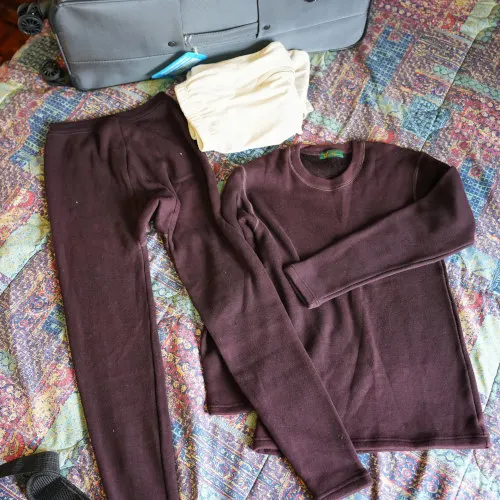
Baselayer is the clothing worn under other clothes to keep you warm and dry
The base layer should be made of wool or other synthetic fibers with thermal properties. Merino wool is undoubtedly the best material because it is highly moisture-wicking. However, it takes longer to dry than other synthetic materials, such as nylon.
Therefore, I have chosen a set of thermal baselayers made with milk silk. Silk is breathable and also an excellent thermal insulator.
Since the temperature in Antarctica was about 0°C during our visit (December), I opted for a base layer that was not too thick to ensure that it was not restricting our movements. So instead, I rely on the mid-layer to keep me warm.
I brought two base layers (leggings and long sleeves shirts), so I have one set to use while washing the others.
Note:
- Clothing made of cotton is not suitable for cold weather. It absorbs moisture and traps it next to your skin, making you uncomfortable.
- Laundry service was available on our cruise.
B. Midlayer
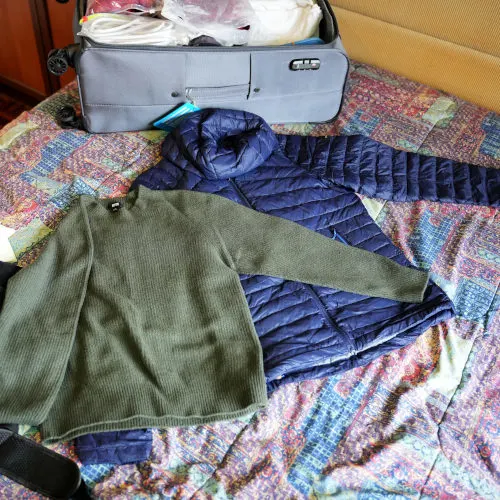
The mid layer is the clothing between the skin-hugging base layer and the waterproof outer layer. It should trap the body heat while not restricting movement, usually made with fleece, down, or synthetic material.
I have my down jacket as the middle layer, which is light and comfortable to wear under the parka. It was so comfortable that I wore it most of the time. However, depending on the weather conditions, I may need to wear a long-sleeved shirt made with polyester as an extra layer.
C. Outer layer (outer shell)
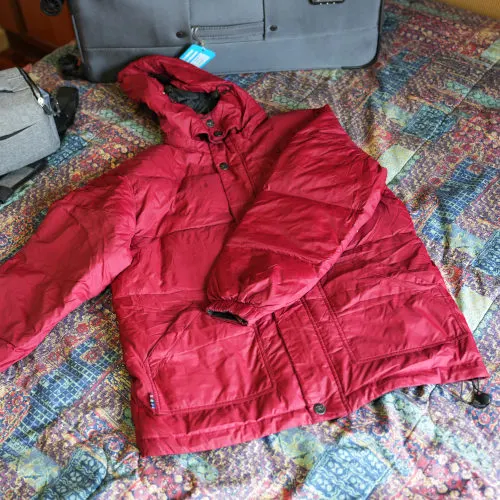
The waterproof outer layers will protect me from the snow, wind, and water during the excursion. The outer layer was mandatory because we were sure everyone would get wet during the excursion.
- Parka
Our expedition cruise will provide a parka, so we do not have to purchase our own. The parka will be mine eventually, and I can bring it home.
The parka's color is bright, intended to be easily spotted against the ice. In addition, it is a windproof and waterproof jacket, which is a must for every outdoor trip.
- Waterproof pants
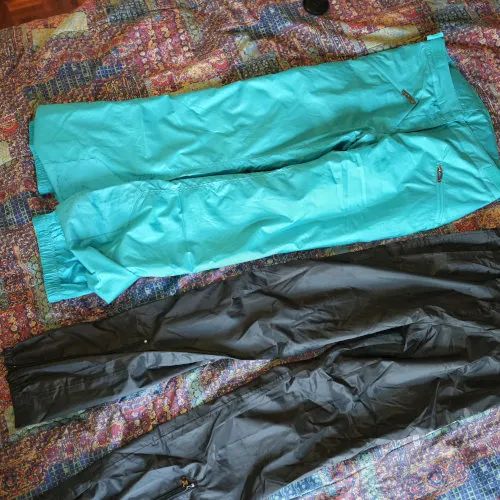
Waterproof trousers are a must in the Antarctic packing list because I will definitely get wet during the execution. I also brought wind-resistant and waterproof snow pants with an insulating inner lining, a must for wet landings. These insulated trousers are necessary as the parka did not protect my legs. It also has a zip at the bottom to get over my boots easily. Besides the snow pants, I also have another pair of waterproof hiking pants with no insulation, which I wear in milder weather.
2. Other clothing
Besides all the layers I mentioned, which are the most important, the followings are equally important if you want to be comfortable and protect yourself in that extreme weather.
A. Gloves
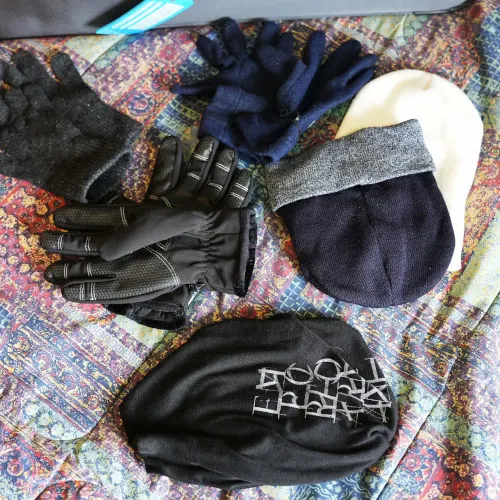
I have three gloves, a touchscreen glove, a waterproof glove, and a thinner one as the inner glove.
The waterproof gloves are the warmest but were too bulky to be used while taking photographs. Therefore, I wear it over my inner glove during the excursion as it could easily slip[ed out, and I can operate my camera with my inner glove.
The third pair is a touchscreen glove with an inner lining. I use it when the weather is not too cold and whenever I need to use my mobile.
B. Hat, beanie, neck gaiter.
I brought a thermal hat (beanie) that can cover my ears. I brought two, just in case one gets wet.
The neck gaiter kept me warm when I was on the boat. In addition, I could pull up the neck gaiter to cover my nose and ears when I felt cold.
C. Socks
Socks are essential to keep us warm but are often neglected. It is very uncomfortable with wet socks, so I brought four pairs of wool socks, so I could use another pair when one has not dried yet after washing. The last thing I want is to wear wet socks.
I have some thermal socks made with a wool blend. Merino wool has excellent moisture-wicking properties to keep my feet dry.
D. Others
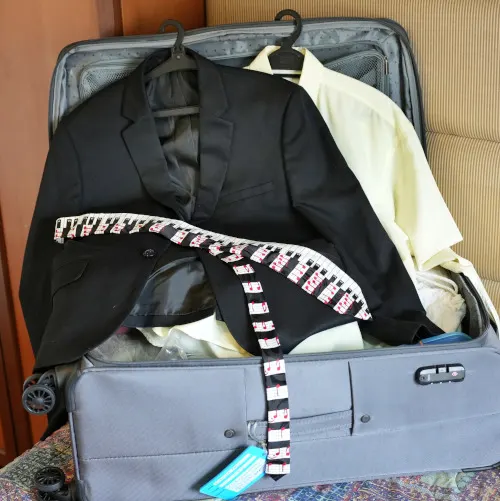
- Besides the winter closing, I also brought some lighter clothing, such as jeans and T-shirts, to be warned when I was in Buenos Aires. The temperature at Bueno Aries was about 21°C during our visit, so we needed a separate set of clothes.
- I had my swimsuit/bathing suit for the polar plunge, the activities that you should not miss in Antarctica. Besides that, I used it for swimming in the heated swimming pool on our cruise.
- I also brought my favorite pajamas to ensure a good night's sleep.
- I have a set suit jacket with matching pants for the gala dinner, which requires a formal dress code.
- My list also includes a few hand warmers to keep your hand warm during the execution.
- Face masks were a must. I wore a face mask during our entire trip from Kuala Lumpur to Argentina to ensure we would not get infected and barred from boarding the cruise.
- Lastly, it is crucial to bring your sunglasses because it is very bright in Antarctica, especially due to the reflection of the snow and ice. Therefore, getting a pair of sunglasses with polarized glass lenses is best. This kind of glass will give you a crispier and sharper vision.
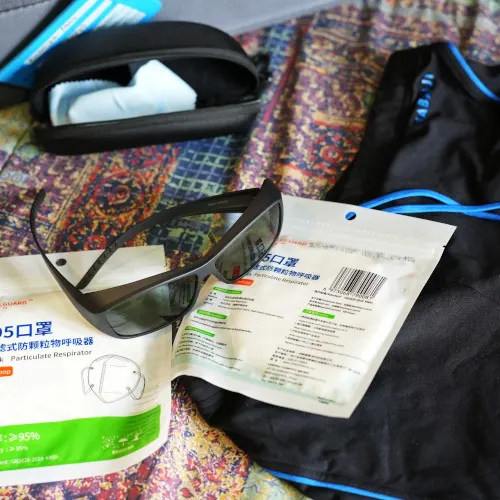
Note:
- Jeans are not recommended.: They absorb moisture quickly, they are difficult to walk long distances in, Jeans take a very long time to dry, and they let body heat escape.
- Wearing cotton clothing is fine on the ship. However, the cotton is terrible at wicking when layering up and won't let your body breathe.
3. Footwear
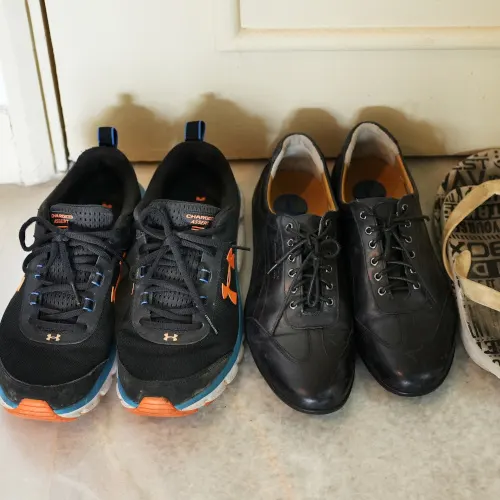
I brought a few pairs of shoes for different reasons
- Our Antarctica cruise provided me with waterproof boots. These boots reach mid-calf, so I can step in 20 cm of icy water without getting wet. These boots are rubber and waterproof with a nonslip sole. Therefore it is ideal for walking on ice with unstable terrain. Please check with your cruise organizer to ensure they will provide the boots for you.
- It brought a pair of sports shoes for use in the gym. It also doubled up as a sneaker whenever I was on the cruise. So I could slip into it quickly, especially when I needed to rush to the deck when our expedition team spotted whales or other animals around the cruise.
- I also had a pair of formal shoes for the gala dinner.
- One more pair of sandals for use in the cabin.
4. Toiletries
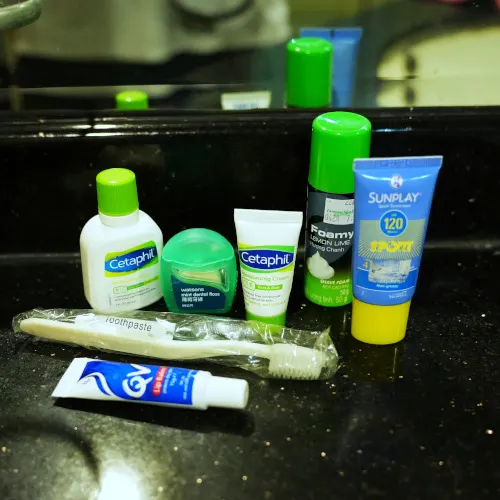
- Moisturizer - The relative humidity of air at the South Pole is as low as 0.03%. It is a polar desert, the coldest, windiest, and driest continent. I had my face cream and a lotion for the body. I ensured I had enough to apply a copious amount to avoid crack skin.
- Lipbalm - Lipbalm is mandatory due to the dry weather. Apply the lip balm at all times, especially during the zodiac cruises.
- Sunscreen - I need to protect myself from UV light as the ozone layer is thinnest above Antarctica, coupled with the white snow and ice reflection. Although I was covered except for my face while outdoors, sunscreen was still applicable to protect my face. Since some people are allergic to sunscreen, I suggest you test it before embarking on your Antarctica trip to avoid causing allergic reactions during your trip.
- Other personal toiletries - toothbrush, toothpaste, dental floss, shaver, shaving foam for men.
5. Traveling documents and others
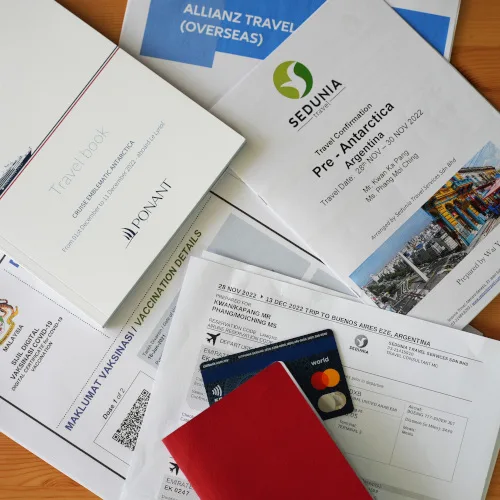
The Antarctica packing list won't be complete if I miss out on the following items.
- Travel Insurance - It is strongly recommended to purchase travel insurance that covers your trip. We bought travel insurance that covers us worldwide since we had a few connecting flights before reaching Ushuaia. The insurance should, at the minimum, cover the luggage and medical expenses. Please note that all the insurance companies we approached do not cover what happened in Antarctica, so I had to be careful during the excursion.
- Passport - needless to say, you need your passport. Please find out whether you need a visa during your entire trip.
- Credit card - Credit cards and debit cards were useful. I informed the respective banks about our itinerary. It reduced fraud and ensured that they could transact in countries I visited.
- Vaccination documents. Check with your cruise agent the requirement to embark on the cruise, and the country visited. You must do a PCR test within 96 hours before boarding the cruise.
Note: The Antarctica packing list should also include I have hard and soft copies of all the essential documents to ensure easy retrieval during unexpected circumstances.
6. Camera gear
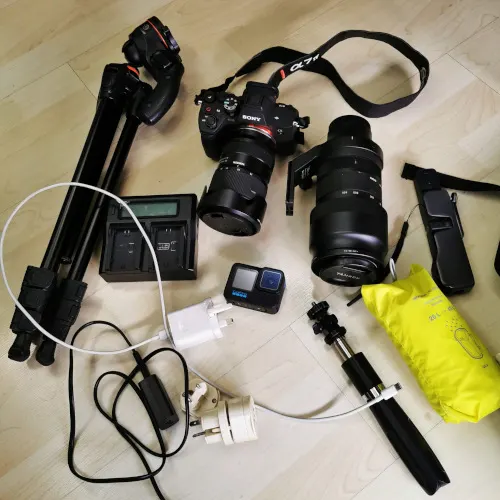
The camera gear in my Antarctica packing list is longer than most people because I am an avid photographer. I will elaborate more in this section.
- The primary camera I used is a Sony a74, in which I mounted the Sigma 100-400mm telephoto zoom lens. A telephoto lens was essential since I had to take photographs of wildlife from a distance.
- The second camera was DJI pocket 2. It is wide angle and has an in-built gimbal which was super useful for capturing videos and landscape photographs.
- I also brought my GoPro, especially when I took pictures during the polar plunge.
- Lastly, my handphone served as the backup.
- I carried the tripod whenever possible as photographs taken with the camera mounted are clearer and sharper, especially wildlife photography from a distance.
- Please note that visitors cannot fly drones in Antarctica unless they have a special license. Therefore, if you are a casual traveler, do not bring your drone during your trip.
- You can use your mobile to take photographs and videos if you are not a serious photographer. To the bare minimum, you need a mobile with a reasonably good camera as you do not want to miss all those precious photography opportunities.
Note: I need at least two cameras, one with a telephoto lens for wildlife and the other for landscape photographs. It is too troublesome to change lenses in the Zodiac or ton the thick snow.
7. Other gadgets for excursions
- We used our binoculars to watch the wildlife from a distance, which was extremely useful.
- The storage space on my cameras was insufficient since I planned to take plenty of photographs and videos. Therefore, I had my laptop with an external hard disk to store the photos and video. I downloaded all the footage from my camera to the laptop daily, then reformatted the SD card daily.
- There are two SD cards in my Sony camera. One was in use, and the other was a spare card.
- Battery chargers - I ensured all the necessary chargers - handphone, camera, computer, etc. were in my luggage bag.
- Universal travel adapter - I brought two universal chargers since the sockets of the hotels and cruise sockets did not fit my electronic gadgets. I also brought a multi-plug so I could charge a few gadgets simultaneously.
- I had three batteries for my primary camera. A fully charged battery would not last for the whole day, especially when I took a lot of video footage. Battery usage is also faster during cold climates.
- I fully charged my power bank all the time, just in case my camera ran out of battery.
- I did not bring my waterproof bag, so I had a separate waterproof cover for my backpack during the Zodiac excursion.
- Finally, I kept the camera in a transparent plastic bag during the Zodiac ride to prevent the seawater from splashing onto the camera. (I use a Ziplock bag for this purpose).
- My wife had a pair of hiking poles to walk on ice. I used my tripod doubled up as the hiking pole.
8. Medication
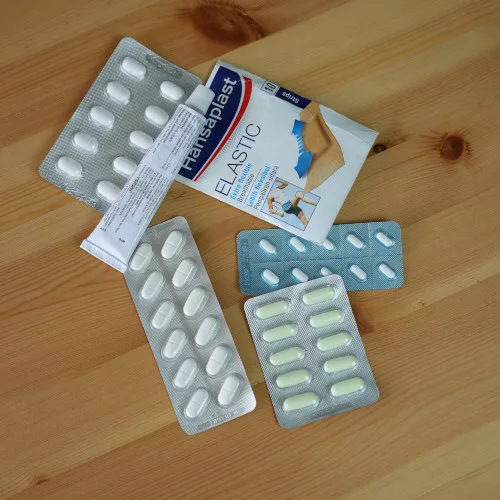
The last group of things on this Antarctica packing list is your medication.
- Traveling sickness pill Is indispensable since we sailed across the Drake Passage. The Drake Passage is the roughest and most treacherous ocean in the world. The seasickness pill helped us to continue our daily activities in the cradle of the sea. The most common brand of non-drowsy seasickness pill is called Dramamine. The brand name may differ in different countries, but as long as the generic name is dimenhydrinate, it should be OK. It is available as a non-prescription medication in Malaysia.
- Some common medications in my small medicine bag included painkillers (acetaminophen) and medicine for diarrhea and stomach upset (Lomotil and Buscopan).
- Also, some plasters and antiseptic creams, just in case. Antihistamine (e.g., cetirizine) is also helpful for flu and allergic reaction.
- I also contacted my doctor to get sufficient prescription medications for the trip. It could be disastrous if I forget to bring them.
Note: I kept the essential medicine in my hand luggage, plus a small bag of toiletries. This can be important if there is a delay in the delivery of your baggage by the airline.
The ultimate Antarctica packing list
If you find this article helpful, please download the Antarctica packing list by clicking here.

Further reading: I found this website which provides everything you need to know about Antarctica. I use it as my primary reference for writing and preparation before my expedition.
